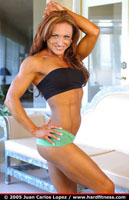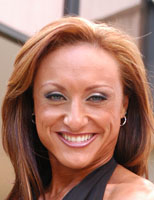 | ||||||||||||||||||||||||
| | |
|
| |
| | |
|||||||||||||||||
| |
||||||||||||||||||||||||
| |
|
|||||||||||||||||||||||
|
Sport Specific Training and Conditioning: Utilizing your Heart Rate Monitor by Traci Redding People often ask me “what should I do for cardio” or more often “how much cardio should I do?” Well, those questions are difficult to answer without knowing what each individual person’s goals are. Some people obviously are going to need to do more cardio than others and some will need to do less depending on what there body type and initial conditioning are.
The one key factor to cardio whether a person is doing cardio 6 days a week or 3 days a week, twice a day or once a day, is there heart rate during a cardio session. I have been working out and doing cardio for over 10 years, but it was not until I started training with a heart rate monitor did I truly understand how to train and what worked for me and what did not work for me. Training by my heart rate allowed me to make sure I was not under training or over training. I will first start off with how to calculate your maximum heart rate. Take your age and minus it from 220, that is your maximum heart rate. For example, I am 28 years old so 220-28 = 192, this is my maximum heart rate. Now that you know how to calculate your maximum heart rate you must understand how to train utilizing your heart rate monitor. I am giving you information in which I use to train; this type of training in my opinion is the most effective, however depending on what your goals are will reflect how you apply this calculation to your cardio sessions. In the following paragraphs, I will explain the different Heart Rate Training Zones and which ones I prefer and how I apply them to my training. To begin, there are 5 Zones that I am going to discuss. I have gathered this information over the years from different educational seminars and certifications, as well as personal research and experience. Zone #1 The Warm up Zone: This Zone is self explanatory, being that this is the Zone in which you start your cardio session at which is 50%-60% of your maximum heart rate (MHR). So my warm up zone is 220-28 = 192 X .50-.60 = 96-115. So in the first 5-10 min of my training I should be in this Zone. This zone is very effective for beginners; it is great for decreasing body fat, blood pressure and cholesterol. The least amount of calories are burned in this zone, yet 85% of the calories burned are fat. Zone #2 The Recovery Zone: This Zone is 60%-70% of your MHR so my recovery zone is 115-135. This Zone is also known as the Fat Burning Zone. Training in this Zone develops basic endurance and aerobic capacity. I also use this zone as recovery from the Red Line Zone which we will discuss later. This Zone burns more calories than the Warm up Zone, yet the same amount of Fat which is 85%. Zone #3 The Aerobic Zone: This zone is well known for developing the cardiovascular system in which you train at 70%-80% of your MHR. So my Aerobic Zone would be 135-154, this zone is great for endurance training. It increases the body's ability take oxygen to muscles and carbon dioxide away. More calories are burned in this zone, yet less from fat being 50%. Zone #4 The Anaerobic Zone: This Zone is the zone that I most often train in during a cardio session. Training at this zone develops the lactic acid system, which can make it difficult for many people to train at this level. The Anaerobic Zone is 80%-90% of your MHR, so once again using me as an example my heart rate would be 154-173. At this zone glycogen in the muscles is predominately used. At this level more calories are burned, but less from fat being 15%. Zone #5 The Red Line Zone: This is my absolute most favorite zone to train in!! At this level your heart rate will be 90-100% of your MHR. My red line heart rate is 173-192!! This is a great feeling, yet you will only be able to train at this heart rate for a very short period. At this level is when you often get that “I feel nauseated” feeling. This zone helps develop the fast twitch muscle fibers and helps develop speed. This is a great zone to use while doing interval training. This level without a doubt burns the most calories, which is why I love it!! Calories in versus calories out!! So know that I have explained the different Zones and how to determine your MHR I will give you some examples of how I apply these Zones to my training. Obviously like most competitors my cardio changes throughout the year which means that depending on what type of cardio I am doing and what my goals will directly affect which Zone I choose train in.
I feel that I train at a very intense level most of the time throughout the year. I teach 2 cycle classes per week in which I stay in Zone #4 most of the class keeping my heart rate around 170’s. During times in which I choose to sprint or climb at a very high level I take my heart rate to 190’s, which is the Red Line Zone. This is my favorite type of training and it is what I feel gives me the most results! On days that I have what my trainer calls “light cardio”, I walk at an incline at a moderate speed, in which my heart rate is around 150-160’s still the Anaerobic Zone. Then I hit the track 2-3 times per week about 8 weeks out from a show, during this type of training I hit all the Zones and train at a very high level. In conclusion, it is very important to reevaluate your
cardio sessions and see what you could do to maximize your training.
It is my opinion that training by your heart rate and knowing your MHR
and what the different Zones is without a doubt the most effective way
to train and to actually see results. A true sign of an athlete is one
who trains according to his heart rate and knows how to reach his maximum
potential. Training by your heart rate is a great way to motivate yourself
during your workouts as well as making sure that you are not over training
or under training. So now that you are well informed on what your MHR
is and how to utilize the different Zones put your heart rate monitor
on and grab your gym bag and head out to do your cardio!! |
|
||||||||||||||||||||||
| |
|
|||||||||||||||||||||||
| |
||||||||||||||||||||||||
 |
|
 |
||||||||||||||||||||||
| |
|
|
|
|
|
|
|
|
|
|
|
|
|
|
|
|
|
|
||||||


